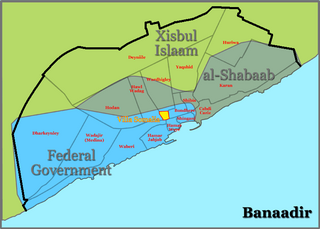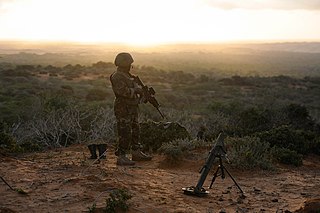
The Ethiopian occupation of Somalia, also called the Ethiopian invasion of Somalia or the Ethiopian intervention in the Somali Civil War, was a conflict largely involving Ethiopian forces and the Somali Transitional Federal Government (TFG), supplemented by troops from Puntland. The initial weeks of the conflict focused on deposing the Somali Islamist group, the Islamic Court Union (ICU), but the hardline militant group Al-Shabaab soon took center stage as an insurgency intensified in the wake of the ICU's collapse.
The Battle of Beledweyne took place in July 2008. It began on July 1, when Islamic militants from al-Shabaab attacked Ethiopian soldiers in the town of Beledweyne, Somalia, which was defended by a garrison of Ethiopian troops.
The Battle of Kismayo began on August 20, 2008 when Ogaden clan fighters took the battle to Ethiopian forces in Kismayo and their protectorate clan, the Marehan clan. Fighters began an offensive to conquer the Southern Somali port of Kismayo from pro-government militias. Three days of fighting reportedly killed 89 people and injured 207 more. The Ogaden clan led by Ahmed Madoobe took the town, at the expense of the Marehan clan who were up to that point kept in the city by the Ethiopian army. After the retreat of the Ethiopian army, the Marehan militia led by Barre Hiiraale were seen fleeing the city in all directions before eventually succumbing to Ras Kaambooni on August 22.

The 2009 timeline of events in the Somalia War (2006–2009) during January 2009 is set out below. From the beginning of February the timeline of events in the Somali Civil War (2009–present) is set out following the conclusion of the previous phase of the civil war.

The Somali Civil War (2009–present) is the ongoing phase of the Somali Civil War which is concentrated in southern and central Somalia. It began in late January 2009 with the conflict mainly between the forces of the Federal Government of Somalia assisted by African Union peacekeeping troops and al-Qaeda aligned al-Shabaab militants.

The Battle of Mogadishu (2009) started in May with an Islamist offensive, when rebels from al-Shabaab and Hizbul Islam attacked and captured government bases in the capital of Mogadishu. The fighting soon spread, causing hundreds of casualties, and continued on at various levels of intensity until October. The battle's name usually includes the year, when referenced, in order to distinguish it amongst the nine major Battles of Mogadishu during the decades long Somali Civil War.

A series of battles in Hiraan, Shabeellaha Dhexe and Galgudug, between rebels of al-Shabaab and Hizbul Islam and Somali government forces and ICU militants loyal to the government, erupted during spring 2009. The fighting led to al-Shabaab capturing major government strongholds and Ethiopian forces re-entering Somalia and setting up bases in Hiraan. There was a halt in fighting during a government offensive in Mogadishu, which started on May 22.

Ahlu Sunna Waljama'a (ASWJ) is a Somalia-based paramilitary group consisting of moderate Sufis opposed to radical Salafism. The group opposes hardline capital punishment, stonings, and limb amputations advocated by extremist interpretations of Islam, as well as laws banning music and khat. The group seeks to protect religious shrines from demolition.

The Battle of Mogadishu (2010–11) began on 23 August 2010 when al-Shabaab insurgents began attacking government and African Union Mission to Somalia (AMISOM) positions in the Somali capital of Mogadishu. Al-Shabaab began its offensive after its spokesman said the group was declaring a "massive war" on troops sent by AMISOM, describing its 6,000 peacekeepers as "invaders". In December 2010 the number of AMISOM troops was increased to 8,000 and later to 9,000. The battle's name usually includes the years, when referenced, in order to distinguish it amongst the nine major Battles of Mogadishu during the decades long Somali Civil War.

This is a 2011 timeline of events in the Somali Civil War (2009–present).

Sheikh Mohamed Said Atom is a Somali arms-smuggler, faction leader and al-Shabaab commander. On 7 June 2014, Atom surrendered to the Somali government.
The Battle of Gedo is a conflict of the 2009–present phase of the Somali Civil War. Centered in the region of Gedo, it pits the Somali government and its allies against the al-Qaeda-aligned militant group Al-Shabaab.

Operation Linda Nchi had the Kenya Defence Forces enter southern Somalia beginning in 2011. The Kenyan government declared the operation completed in March 2012, but its forces then joined AMISOM in Somalia.

This is a 2012 timeline of events in the Somali Civil War (2009–present).

The Battle of Kismayo was an offensive led by the Kenya Defence Forces, under the codename Operation Sledge Hammer, to seize the port city of Kismayo, Somalia, from Al-Shabaab from 28 September 2012. Fighting alongside the Kenya Army were Raskamboni movement militia and the Somali Army.

This is a 2014 timeline of events in the Somali Civil War (2009–present).

Operation Indian Ocean was a joint military operation between the Somali military, AMISOM and the United States military against the Al-Shabaab militant group aimed at eliminating the remaining insurgent-held areas in southern Somalia. It officially began in August 2014.

This is a 2015 timeline of events in the Somali Civil War (2009–present).
This article contains a timeline of events for the Somali jihadist group al-Shabaab.

This is a 2016 timeline of events in the Somali Civil War (2009–present).













